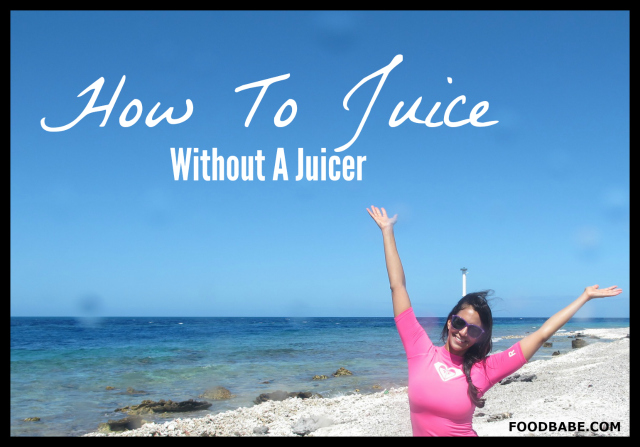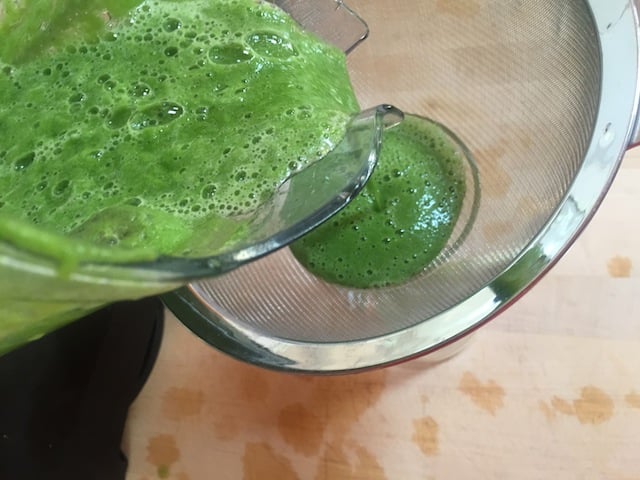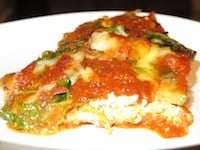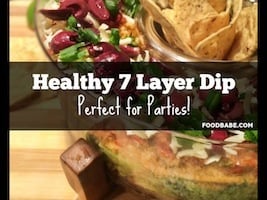I had a blender for many years before I had a juicer and it’s the perfect tool to learn how to juice without a juicer! I know investing in a new kitchen appliance can be tough, especially if you are new to juicing, so I’m taking the opportunity to share this simple technique with you. This method works great for times when you don’t have access to a juicer or while traveling. I don’t know many people who travel with their juicers, those luggage fees are crazy and we need the extra room for shoes, right?! 🙂

If you’ve been following me, you know I try to juice at least 3-5 times a week and on a good week, twice a day! Just to recap…
The Top 3 Reasons Why I Juice:
1. It’s really hard to get the amount of vegetables required by most experts (6-8 servings) in a typical day. I don’t know about you, but when I wake up, I don’t crave a big bowl of collard greens or broccoli. It’s rare to see Americans eating vegetables for breakfast, and at lunch it could be as small as a piece of lettuce and tomato on a sandwich, leaving very little room in the day to get that 6-8 servings. It takes a few pounds of vegetables to get a 12-ounce glass of juice – which gives you the whole day’s worth of servings in one glass. Additionally, juicing allows you to get a wide variety of vegetables you would probably not otherwise consume in your diet, giving your body the variety of vitamins and minerals it needs to repair damaged cells, prevent disease, and keep you looking and feeling younger.
2. Drinking juice gives you a ton of energy. When juice is separated from the fiber of fruits and vegetables, it is easier for your body to absorb all the nutrients, giving you an instant boost of energy. Consuming the abundance of live enzymes, vitamins and minerals in juice is like drinking a natural version Red Bull. There’s nothing wrong with a little organic coffee, but my daily habit was eliminated after I started having fresh juice daily. I simply didn’t need it anymore to feel awake and alive.
3. Our soil is depleted. Due to the use of pesticides, genetically modified seeds, and conventional farming practices, several vitamins and minerals have become depleted from our soil. Eating a piece of broccoli now vs. 20 years ago does not yield the same amount of nutrition. It’s crucial that we try to overcompensate this fact by consuming as many whole plant foods as possible. Juicing allows you to get the extra boost you need much more efficiently than trying to chew vegetables all day. When I started drinking carrot juice, my eye lashes immediately started to grow longer within just a couple of weeks. Feeling the extra energy boost is one thing, but seeing the results in the mirror can be quite dramatic and make you a firm believer of the powers of drinking juice.
How to Juice Without A Juicer
Below are step by step instructions on how to juice without a juicer: All you need is the vegetables and fruits you want to juice, a fine mesh strainer or nut milk bag, and a high powered blender. (FYI: Here are my recommendations for blenders and juicers in case you are wondering!)
Step 1:
Clean your organic fruits and vegetables thourougly – I like to completely submerge my leafy greens in water and let the dirt and sendiment fall to the bottom of the bowl, and rinse the greens twice more with fresh filtered water.
Step 2:
Add a few tablespoons of water to a clean blender, juice of one lemon (if part of the recipe) and slowly add the dark leafy greens. I find that blending the greens first produces the best result – you only need to blend for about 30 seconds.

Step 3:
Add other fruits and vegetables and blend well (about 1 or 2 mins)

Step 4:
Strain mixture through a fine mesh strainer or through a nut milk bag for a less pulpy silky smooth result. (Tip: Some people find it less messy to strain into a large bowl first instead of directly into a glass).

Step 5:
Enjoy your beautiful green juice immediately – do not store the juice for later if you want to get the most nutrition from the juice. This blending method produces some heat and oxidizes your juice more than cold-press juicers.

Please spread the word, let’s get everyone juicing!
If you know someone who hasn’t tried juicing, but owns a blender – please share this post with them! It could be a life saver.
Xo,
Vani
P.S. If you want more juicing tips and guidance, please check out my Juicing Guide here. It includes everything you need to know plus a full 8 day reset menu, recipes and calendar for you to follow.










I couldn’t agree more!! I nurse so juicing is an extra boost of energy and healthy calories that i sadly don’t do everyday but have been much better about! Thanks for the straining tip!
So, how do I make carrot juice with blender? Amounts to add? Never done this. Thanks!
Just curious why you strain it.
Agree.. why can’t we just drink it like a smoothie?
I think because it is a way to juice. You could do either honestly. The juice bar at our farmer market makes any of their juices a smoothie and vice versa.
There are different benefits for juicing vs blending. Juicing gives your digestive system a break while allowing your body to absorb the nutrients quickly and efficiently. Both are good for you and both should be incorporated into your daily regimen.
She’s simply offering a method of juicing if you don’t have a juicer. You can drink a smoothie if you choose. She’s just showing a technique. That’s all.
Thanks. I was truly curious if there were additional health benefits one way or the other.
I agree, why strain? Lots of good fiber in the pulp correct?
“When juice is separated from the fiber of fruits and vegetables, it is easier for your body to absorb all the nutrients, giving you an instant boost of energy. ” First comment from point #2 above. If you leave the fiber in, it takes longer for the nutrients to absorb.
I have a hard time”processing”that satement. I believe the fiber in the green smoothies is much more bioavailable than the ones you get from porridge and cereals and other fiber only just for the sake of fiber food stuff. So green smooties have my vote and are part of my everyday diet. I’m a handyman and work 7 days a week and love the energy I get from it. I wouldn’t strain it for the world.
I totally agree with Steve!
“If you leave the fiber in, it takes longer for the nutrients to absorb.” I guess I’d be asking, “What’s the hurry?”
The nutrients and vitamins in the juice part will still give you a fast boost just as if you had strained it. leaving the pulp (fiber) in to digest more slowly is also giving you sustained energy.
Would a food processor work as well as a blender?
Jan, I don’t know about every food processor, but all of the ones I’ve seen are designed to run at lower speeds than what is required to sufficiently masticate up a fibrous veggies for a smoothie. A good quality high power blender can do many operations for you in your kitchen. They don’t come cheap. I purchased the brand blender that you see everywhere new at Costco and since I had nothing to compare I thought it was awesome. At least until it burned up two months later. Thankfully Costco gave me a full refund. I replaced it with a refurbished unit from their main competitor Blendtec. Which was $100 less and whoa what a difference. This machine is way better. A year and a half later it’s still going strong. Don’t get sucked into the hype of the leading brand like I did if you are looking to buy one. Namaste
Sorry, nothing can compare to the Vitamix. I’ve tried them all. They will replace it, no problem if it stops working.
One caveat on the Blendtec, It’s best to twirl the blade before using. When it stopped working at full strength I thought it was the motor. Nope. Blendtec gave me the suggestion to do the blade twirling. Still had to replace the carafe. 100 bucks or so. Twirl that blade!
Blendtec/Vitamix – everyone seems to have their preferences.
One other thing I’ve heard about both. They run so fast they go beyond masticating and destroy the value of the fiber. It might be an advantage to use a slower, conventional, quality blender. Strain if you don’t want the fiber.
One caveat with the Blendtec. The blade needs to be twirled before daily use. I didn’t and when I called Blendtec thinking it was the motor, they said it was the carafe needing that maintenance. 100 bucks for a new carafe.
One other thing about juicing with either blender, Vitamin or Blendtec. I’ve heard it said they run so fast they shred the fiber so fine as to take away any of it’s value. A conventional blender might be actually better if you want fiber in your juice.
Everyone has their bias: Blendtec vs. Vitamix.
HealthMaster, y’all, HealthMaster. I LOVE mine. So versatile and does it up right! Got to get me a micro screen. Use left over bulk fiber in carrot cake! Or make it like a zucchini bread recipe! No having to twirl the blades! It will chew up anything!
I don’t go a day without my smoothie. I really never thought I could make a healthy juice without my juicer. Interesting! Thanks for another great post, Food Babe!
Unfortunately, extensive juicing can lead to a fatty liver when the fructose goes straight to the liver and converted into lipid for storage on the organs.
There are a lot of calories in juice. Juicing might not be the way to go If you are trying to lose weight.
That is why you want to make sure that you are not just juicing fruit. The majority should be leafy greens and vegetables. Add a small amount of fruit to give the vegetable juice desirable flavor
You are not a hater Bill. Juicing is new to me and I also question the health aspect of too much juicing. Our bodies need the benefits of chewing food and mixing with saliva. The juice drinks taste wonderful but I think moderation is the key.
I am curious too. Why straining? Are there more benefits if you do this or drinking it after blending is the same thing?
What if I don’t strain my juice? What are the health benefits? because I always blend and drink right away
I have to agree with Bill your body doesn’t need that much sugar at once. As for you Arnie –just because someone disagrees with you or food babe doesn’t mean the are pro big pharma it means they have a different opinion…perhaps a more informed opinion. Calling people names doesn’t make you right or a better person.
Overall, juicing is healthier than all the other crap people put in their body.
Shame, shame for name calling.
How much sugar can there be in green leaves and a cucumber? Seems better to me than drinking a cup of apple juice from concentrate.
Thank you Caroline. People get so bent out of shape in these discussions. Makes no sense – just do what’s best for you!
Ok Vanni.
I have tons of wild lambs quarter in the yard. Love to juice it, except I add a pinch of sea salt, ice cubes and a jot of evoo.
and be careful if you start picking weeds. My boy scout son pointed out to me one plant which is poisonous. so be careful but enjoy.
see google images for photos of lambs quarter. It’s so much better than spinach. Yes!
Linda West Eckhardt
Editor/
everybody eats news
I have Crohn’s disease and excessive amounts of fiber irritate my stomach, so for me, straining makes sense. Also, I have a juicer and a blender, but it takes so much more fruits and vegetables in the juicer to get one glass of juice. I prefer the blender.
I’m with you. Visit Dr. Axe online and look at his food recommendations for Crohn’s. I am sipping his bone broth soup recipe right now.
Why not just do green smoothies and get all the good fiber too! 🙂 Thats what I do
I not a juicer not that oppose it I get my veggies/fruits from another source ..but just washing the fruit/veg it not cutting it you would be shocked what is left on even organic .I use something from my company that get them the healthiest they can be ..Left in the bowl in water in a couple of minutes the water will look like Mud .If anyone would like more info let me know
Jon, I would love the info on the product you are using to clean your veggies.
Thanks in advance.
Hi Theresa ,
Thanks for your reply you can go to my site at http://goo.gl/sYJKkV click the products tab and it will pull up another page on the left click the home Care and you’ll see OrganiCleanse it’s just 1 of our over 200 Chemical and Toxin free products . If you have any questions and would like to contact me by phone let me know
OR, you can use a large bowl of water with a tablespoon of vinegar in it. Swish well, rinse and spin in salad spinner to remove moisture. Fruits and veggies are clean and do not taste like vinegar!
Thanks for your response John. I will check it out. I use vinegar and water to clean my fruits and veggies now and am quite satisfied. Just checking out other safe solutions to use.
How much fruit should we put in a juice?
My rule of thumb is 1 fruit for every 3 vegetables. e.g. 1 cup fruit (low sugar fruits like berries) for 3 cups of vegetables.
I think there is a place for both smoothies and juice. I think juicing is very important for someone with cancer or an autoimmune Disease. Because the fiber is taken out the body can rest and recover. It doesn’t have to work as hard. I drink green smoothie almost everyday but if I became sick I would juice.
I was just diagnosed with breast cancer. I’m going to do a cleanse. I don’t have a juicer, but I do have a vitamix. Why do you recommend juicing over the whole plant?
Don’t we want more fiber? Juicing may keep vital minerals and vitamins, but we want FIBER!
Thanks! Couldn’t afford nor want a juicer. I think I will try it for a quick one which is all I want, really.
I agree with Sherry. I am a reasonably healthy adult and I drink my greens along with the fiber. If I was sick I’d juice so the micro-nutrients would immediately be available for my body without needing to process the fiber.
But you need the awesome fiber of the Vegies. It is vital for your colon.
If you were to compare Smoothies and Juicing on a ‘contents only’ basis it would show that you get everything that you would get in juice, (plus the pulp and fibre) so juicing is not an absolute necessary component for a healthy diet but you must remember the massive plus of Juicing.
MICRO-NUTRIENT DENSITY!
Because Juicing actually removes the pulp and fibre, you actually get a fortified drink that gives the abundance of vitamins and minerals and plant goodness from several kilos of veggies (and minimum fruits) that you will never be able to get and drink in smoothie form.
Your green smoothie can be a meal because of its bulk however your vegetable juice acts more like a meal supplement because it switches on the Satiety signal (Leptin hormone) and switches off the Hunger signal (Grehlin hormone) far quicker and more effectively than when ‘food’ (bulk and fibre) needs to be processed through the digestive system.
Either way you choose be it juicing or smoothies, be sure to put a greater focus on vegetables than fruit because of the fructose component. Only your liver can break down fructose and too much at one time such as in fruit juice can simply over load it.
I’d suggest that you juice your greens (veggies of every description and the more colour you include the better) and eat your fruits and only use fruit if you find you need to add palatability to the drink so that you maximize vegetables massive nutritional low calorie values and limit the glycemic effects of fruit.
What an excellent and informative post! Thank you.
I had a juicer but ended up returning it after I realized how much pulp I wasted. I couldn’t find an effective way of saving the pulp to use it for cooking. I felt like I was throwing money away. While I agree juicing has it’s benefits I personally, enjoy a smoothie because it takes longer to go through my system. I found that I was hungry more often when I juiced. We love our Vitamix and when I don’t have time to whip up a smoothie, raw fruits and veggies are the way to go and a wonderful grab and go snack that keeps me full for hours.
My dad’s family is from Egypt and a typical breakfast includes Tomato and Cucumber slices, Cheese and, if there’s time Fava beans with lemon, cumin, parsley and pepper.
This breakfast is delicious and will make you feel great after eating.
That breakfast sounds delicious. Eating and watching animal videos. Thought I would share. https://www.youtube.com/watch?v=uzRH0g1uRtc&list=PLMhtDkR0tLzLznevJqMFh-6Pb4pZfxzKz
I’ll stick to drinking my Supermix every day. Less time, less mess, less cost.
Organic- Bio-available & enzymatically active.
http://www.knjhosken.myzija.com
You can also use a nut milk bag to strain out the fiber. I have a hemp bag I bought at Amazon or VitaMix web site, blend my veges in my VitaMix, and then strain out the fiber in my bag. I alternate between smoothies with the fiber in, and the juice. I can take in way more nutrients via the juice than the smoothies.
Also always add something to your smoothie or your juice which has fat – according to David Wolfe the only way you will absorb the fat soluble vitamins from your juice or smoothies is by adding fat to them (avocado, coconut oil, coconut, almonds, chia, olive oil, etc). He talks about this in his 8 minute video – http://www.longevitywarehouse.com/blog/the-most-shocking-fact-about-juicing/ . He also has a new book coming out in May talking about the colors in food.
to health!!! flo
God bless you! I’m so glad I found this info. Just watched his video. He really is a wealth of knowledge. I so appreciate your sharing. Going to share with my dad who also bought a juicer recently. Carrot & coconut oil are a good combo, looking forward to doing that. 🙂
Great Karla!!! Glad it helped you and your Dad! I found it quite fascinating – all these years of juicing and smoothies and not knowing this. I have pre-ordered the new Colors book by David Wolfe.
enjoy! flo
I love juicing. I love the bolt of instant energy I don’t get from smoothies. I use the pulp for salads. I can’t imagine why some choose to throw it out. Besides toppings on salads, it is good to add to sauces or muffins those I don’t make those. But for those who do choose to toss it, most of us that eat healthy get tons of fiber already so no problem there and of course there is soluble fiber in juices. I also drink smoothies for snacks. I am so glad there is no reason to choose one (juicing) over the other (smoothies). Each has its place. I encourage all who are trying to improve their health. Now people that drink soda pop- those are the ones to preach to!
How timely as I’m just about to purchase a masticating juicer. I popped by your page for recommendations to compare with my own research. I’m willing to spend abotu $300 so it will likely be an Omega juicer. I hadn’t thought about straining it after blending. Every morning I do a green smoothie and share it with my toddler. I don’t mind the fiber and it’s great for her too but now this gives me an option until my juicer arrives-thank you!
My skin has always been great and my diet is SUPER clean-all organic, non-GMO, no MSG or food additives but my skin starting breaking out recently. I thought it was hormonal as I’m still nursing but noticed that it became worse after about 4 weeks straight of doing 1 chai latte per day (I never do this and have avoided caffeine since before I was pregnant and my little one is now 21 months but had work deadlines that I had to just press through and was getting 4 hours of sleep per night). A week or so after I stopped and the mild headache from not having it subsided, my skin broke out like something fierce and still hasn’t cleared up.
Now, I KNOW I am not drinking enough water and I still eat dairy occasionally which can be a trigger as I have dairy allergies but it’s been about a month since having any caffeine and I know my liver must need cleansing. I’m really hoping that juicing will help with this as I can’t do any other cleansing until I’m done nursing my little one. Every time I drink carrot juice I think of you Vani! My eyelashes have gotten shorter over time and when I have an allergic reaction to a food sometimes my eye lid gets itchy and a few lashes fall out. I’m really hoping carrot juice can help turn my skin and eyelashes around. For someone who is quite healthy this is very frustrating. I never even really had any breakouts as a teen.
I have had the experience of breaking out from too much coffee. I believe it is the coffee that caused your breakout, only because you were not used to drinking it. I drink it every morning, and I never have a problem unless I drink more than my body is accustomed to.
When I use a juicer to juice the vegetables, I drink the juice and collect the pulp. I take the pulp and place in the fridge. The next day I take the pulp and add a little water and organic apple juice and mix this with the pulp in a blender or nutribullet and drink this. This way their is no waste. I am sure I am getting benefits from doing this.
Yummo!
I really believe in drinking green smoothies daily. I have done it for the last three years and can tell the difference in my well being. I don’t juice however because I like the fiber from the fruits and veggies that I use. I also like that I don’t have the fiber waste to try and use or throw in the compost.
My question is why not use a Vitamix and only have a blend time of 20 seconds? Or a Nutribullet for a blend time of 1 min? I have both. One is for home and the other for travel.
I challenge you to prove the comment you made about our soils being depleted due to pesticides, GMO seed and conventional farming practices. My yields are far greater than they were 20 years ago. Depleted soil would not allow that to happen. Depleted soils are a big problem in other parts of the world because they don’t have access to the technology we have, like pesticides and GMO seed. GMO seed and Roundup has lead to many more acres in this country being no-tilled which is very good for the soil and also water and air quality. Why not tell the real truth instead of taking things out of context to fit your version of the truth?
By yields are you referring to the amount of crops per acre/square foot or would you be referring to the amount of vitamins, minerals, health benefits or taste in each crop?
I meant production per acre but I would add all of those things you mention as well. I know what you want to believe but I don’t think there is any merit to what she said.
http://www.npr.org/sections/thesalt/2014/07/11/330760923/are-organic-vegetables-more-nutritious-after-all
Does it matter what health benefits it has if you can’t eat it?
Let me give you a simplified example. Two fields of strawberries; one conventional and one organic. The day before they are suppose to be picked it rains. By the time the field firms up the organic berries can’t be picked or sold because they have mold growing on them. The conventional field was treated with an effective fungicide that has minimal environmental impact. They can be picked and packaged.
Seriously?, so it’s okay to eat a fungicide which is a poison?
To Hall, If you don’t believe what we do, why do you browse these blogs?
Here’s an article regarding soil depletion:
http://www.scientificamerican.com/article/soil-depletion-and-nutrition-loss/
Interesting article. Thank you for posting it. I copied a part of your article that quotes the authors of the study from U Texas as saying the decline is more related to ag practices designed to improve traits instead of nutrition.
“Davis and his colleagues chalk up this declining nutritional content to the preponderance of agricultural practices designed to improve traits (size, growth rate, pest resistance) other than nutrition.
“Efforts to breed new varieties of crops that provide greater yield, pest resistance and climate adaptability have allowed crops to grow bigger and more rapidly,” reported Davis, “but their ability to manufacture or uptake nutrients has not kept pace with their rapid growth.” There have likely been declines in other nutrients, too, he said, such as magnesium, zinc and vitamins B-6 and E, but they were not studied in 1950 and more research is needed to find out how much less we are getting of these key vitamins and minerals.”
Soil depletion in this country is not the problem that it is in other parts of the world, China in particular. I foresee tremendous benefits with GMO crops eventually being incredibly nutritious. That is not news you want to hear but very possible.
You might want to check the sources and references on your link.
The Kushi Institute claims that a “macrobiotic lifestyle” can reverse cancer and cure other diseases. The AMA Council on Foods and Nutrition said that followers of the diet stood in “great danger” of malnutrition.
The Organic Consumers Association is an organic agricultural marketing organization with a reported revenue over $3 million in 2013. The American Council on Science and Health calls the OCA “always unreliable” and criticized them for promoting unproven natural cures for diseases like Ebola.
Kind of weird that you’re on a site trying to promote a healthier lifestyle and you’d bring up GMOs. Not sure why you think GMOs are preferable to organic. David Suzuki, the PhD geneticist has been quoted “any politician or scientist that tells you these [GMO] crops are safe is either very stupid or lying.” Then there’s this (if you can read the entire article, it’s pretty shocking): http://www.naturalnews.com/040727_GMO_feed_severe_inflammation_pig_stomachs.html
When I went to your link I couldn’t help but notice the other featured articles, the first being that glyphosate killed Joe Biden’s son. I really didn’t need to read any more after that. If you make your life’s decisions on agenda based websites then all I can do is wish you well. You will live your life in fear. I choose not to do that. I look at simple things like how our life expectancy is going up, not down. Farmers are getting older and that’s a problem for agriculture. How could that be if we are exposed to so many toxic pesticides?
David Suzuki is an environmental activist. He may have PhD behind his name but environmental activists hate GMOs with a passion. His desire is for you to fear food.
Oh, Hall… paaalease!!! Alice, right on! David Suzuki is right on! And Hall, try a nice big fat juicy ORGANIC RED TOMATO this summer, and then eat one of your “conventionally” grown pale pinkish, mealy, pasty, dry “tomato”. See which one pleases your pallet the most. Let’s see, I think you can add just about any fruit or vegi to the challenge and get back to us on that, will ya? That goes for seriously too! Your poor pallets are DEAD and you obviously don’t know what real food tastes like. You can advocate for the Hoover Institute, David Koch, GMA, Monsatan, and all the other food destroyers out there, but people who know what real food tastes like are just going to tell you all to stuff it where the sun don’t shine!
I don’t think it’s even a true electrolyte..my chemistry instructor put it through the ‘light test’ and it failed..she had some light bulb hooked up that would literally light up when it came into contact with a true electrolyte and Gatorade did not make the cut..
“Our soil is depleted. Due to the use of pesticides, genetically modified seeds, and conventional farming practices, several vitamins and minerals have become depleted from our soil.”
Our soil is not depleted do to the use of technology and science. Farming methods are yielding more and are in much better shape than they were a hundred or more years ago.
Nutrient deficiency diseases have decreased – not increased. How many people in the US have Scurvy, Beriberi, Pellagra, Rickets or Goiter. How many infants do you see suffering from Marasmus and Kwashiorkor?
Yield does not equal quality. That’s why heirloom tomatoes (just for an example) are so popular, although they aren’t always pretty (which is what many breed for, it has to look nice on the shelf) they are super delicious! Nutritional deficiency diseases have decreased because we know what causes them and how to supplement, not because food is more nutritious.
Yield does not equal quality or nutrition, it just equals more. Nutritional deficiency diseases have decreased because we now know what causes them, and how to supplement. Hashimoto’s thyroiditis is a more common cause of goiter formation in the US, rather than iodine deficiency. Hashimoto’s is an autoimmune condition.
I want to make celery (celery only) juice. Could this be done in the vitamix?
I love the step-by-step instructions! Thanks for giving all the details, otherwise I would be so confused. I think it is a wonderful replacement and something I want to learn and use it my own. Probably a great choice for my son as well 🙂
The type of tomatoes grown is based on several factors. Such as where they are grown, the time of year, what soil type they are grown in. Tomatoes need stand up to shipment across the country and across the world. They need to make it to their destination without rotting or spoiling. Farmers don’t grow tomatoes because they “look pretty” although consumer preference is part of the equation. Agriculture is complex. Please note I have nothing against heirloom tomatoes. I agree that they taste good. I just can’t afford to eat them everyday. There are plenty of people in the world that would rather have a Roma than no tomato at all.
To Alice:
“Hashimoto’s thyroiditis is a more common cause of goiter formation in the US, rather than iodine deficiency. Hashimoto’s is an autoimmune condition.”
You are correct. Before salt was fortified most goiter was caused by a deficiency.
If you don’t have food to eat you aren’t going to be able to correct nutritional deficiencies. Vitamin and mineral supplements come from plants, animals, or the earth if they aren’t made synthetically. If there aren’t enough resources or they can’t be accessed there are going to be deficiencies.
I save the strained pulp and eat it like as my own version of “applesauce.” I like to switch between smoothie/juice and this way nothing is wasted!
Thank you for sharing a new technique! This is great for those of us who don’t have a juicer or perhaps can’t afford to by a new kitchen tool at the moment! I also shared this method with my friend who has Crohns, straining the fibers will make getting veggies easier for her 🙂
Juices, smoothies….mix it up, have fun with it. We don’t have to be tied to one drink or the other. have fun & try new things. Nutrition isn’t one size fits all.
If you blend it then it’s a smoothie, if you strain it after, then it’s juice.
Hi. I just got into juicing and I love it. Thought I definitely feel that I want to start using the blender more often especially since there seems to be more fiber available for blending. I’m just confused about the live enzymes. Should I be worried that my food has dead enzymes? I’m also confused about the micronutrients. How does juicing make obtaining them easier. Please excuse my ignorance, I’ve just begun making these lifestyle changes and have been hoping to learn more.
Thank you so much for this tutorial. I am not ready to commit to buying another appliance but I want to juice myself. I just tried this and although it is messy and time consuming, I loved it!! If I find myself juicing more I will not hesitate to purchase a juicer!
Has FoodBabe ever done a review of Juice Plus? I mean obviously all of us know that the raw, whole, natural fruits and veggies are the best!!! BUT I would love to hear her thoughts on the JP products!!
or…just drink a veggie smoothie…why go thru all of that when you can drink all the vitamins, minerals and fiber provided by the planet…ALSO.wayyyyyyy less expensive than throwing the leftovers away…JS
Chris Beat Cancer says not to worry about fruits and veggies. Just juice or eat them. This thing about fruit being too sugary is not true. Your body knows how to process natural food. Especially needed for cancer patients. Check out his website.